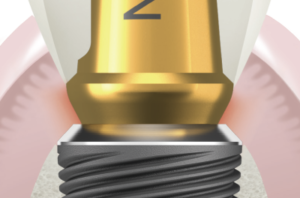Sealed prosthesis on implant, a complete range for all your restorations
Sealed prosthesis or screw-retained prosthesis? It’s difficult to say since the choice will be made based on the clinical situation and above all on your preference as a clinician. The best technique is the one you are most expert with.
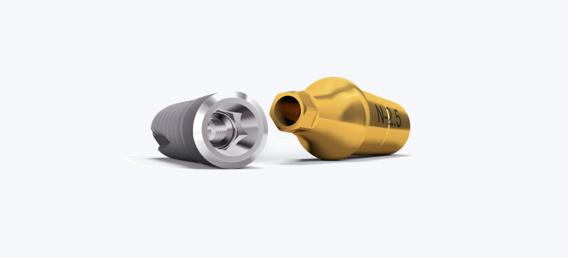
A Complete Range
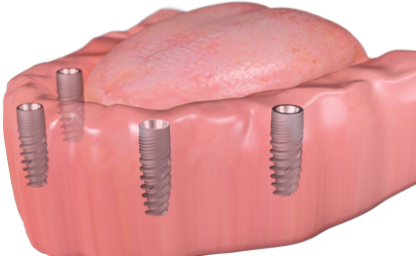
Our Connections
Internal hexagonal conical connection
Sealing of the connection
Prosthetic stability Adjustment precision (6 positions)
Mechanical solidity
Single connection
For all diameters
For the 4 implant systems
Emergence switching
Connective tissue development chamber Protection of the biological seal Isolation of gingival inflammation far from the crestal bon
Internal octagonal conic connection
Sealing of the connection Prosthetic stability Adjustment precision (6 positions)
Mechanical solidity
Single connection
For the 2 implant systems simple management of prosthetic parts between the dental practice and laboratory
Cement-retained restoration
Let’s start the journey towards success and enhance revenue for your business. Take your company to the next level.
All clinical indications
- Technique on false stump similar to the technique on natural stump
- Occlusal surface preserved
- Aesthetic result:
- Very wide selection of materials and abutments
- Uniformity of the cosmetic material (no screw access socket)
Drawbacks
- Risk of sealing cement spilling over in sub-gingival position
- More difficult to remove
- Risk of unsealing
Criteria for selecting prosthetic abutments
- Clinical indication: single-unit, multi-unit or complete edentulism
- Sector of the mouth
- Aesthetic requirement
- Divergence between the prosthetic axis desired and the implant axis
- Assessment of the biological width
- The occlusal and interdental spaces
- Impression taking technique:
- Direct implant
- Direct abutment
- Digital impression
Temporary screw-retained abutment
Manufactured in the laboratory Long-term temporization
Temporary direct abutment
Temporization in the chair: simplicity of use Provisional crowns and bridges Rotation and anti-rotation plastic caps to support the provisional prosthesis Available exclusively on the 3N+ range
Clinical indications
Single-unit and multi-unit edentulism For entire mouth sector Ideal for aesthetic sector
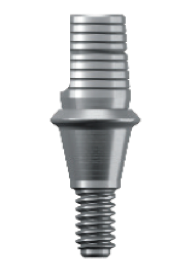
Clinical indications
Single-unit and multi-unit edentulism For entire mouth sector Ideal for aesthetic sector
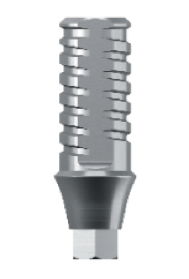
Aesthetic profiles adapted to your requirements
Several emergence profiles available to match the tooth to be replaced as closely as possible: 4 diameters and 5 gingival heights (identification by laser marking) 3 angles to compensate for divergences between the implant and prosthetic axes Preservation of the gum: healing abutment’s emergence profile identical to that of the relevant final abutmentSafety and reliability
Abutments supplied with a titanium captive fixation screw: the screw is held by thread inside the prosthetic part thus preventing it from falling out. Fixation screw with anti-unscrewing protection.Clinical indications
Single-unit, multi-unit and complete edentulism For entire mouth sector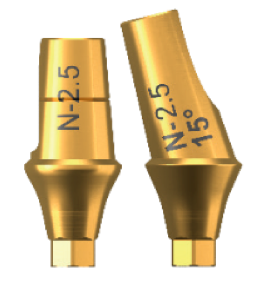
Preserving the biological width for a better aesthetic result
Immediate and permanent placement of the abutment to preserve the connective tissue Direct impression taking on the abutment = POP-UP TECHNIQUE using Direct Clip clipped transfersSimplicity
Several prosthetic profiles available according to the tooth/teeth to be replaced (identification by laser marking) DIRECT CLIP kits containing all parts needed for restoration on the chosen abutmentClinical indications
Single-unit, multi-unit and complete edentulism For entire mouth sector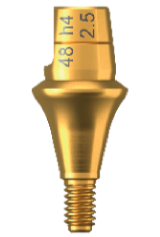
For manufacture of personalised abutment using traditional technique in the laboratory on cobalt-chromium abutments Correction of angles of 20° à 30° beyond those of prefabricated angled abutments available
Clinical indications
Single-unit, multi-unit and complete edentulism
For entire mouth sector
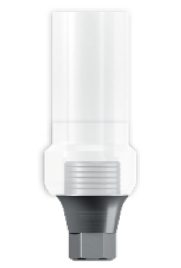
Screwed restorations
Benefits
- Easy removal
- Small prosthetic space
- No sealing cement
- Restoration more suited to bridges
Drawbacks
- Occlusal surface modified
- Possible risk of unscrewing
- The implant axis is not suited to the ideal lingual or occlusal positioning of the screw access socket
- Screw access socket is visible
Criteria for selecting prosthetic abutments
- Clinical indication: single-unit, multi-unit or complete edentulism
- Sector of the mouth
- Aesthetic requirement
- Divergence between the prosthetic axis desired and the implant axis
- Assessment of the biological width
- The occlusal and interdental spaces
- Impression taking technique:
- Direct implant
- Direct Abutment
- Digital impression
Removable restoration
Adapted to the Majority of Implant Solutions
The smallest attachment system on the market Compensation of divergence of implant axes by 35° maximum and 50° using SMART BOX EQUATOR
Clinical indications
Complete edentulism Mandible and maxilla
Ideal for cases of
Denture on attachment Stabilization of full assembly
Different levels of stabilization according to the patient’s wishes
4 sheaths of different hardness available to adapt retention of the prosthesis
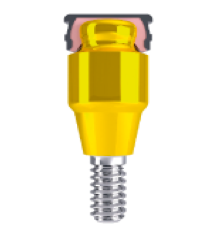
Adapted to the majority of implant solutions
Different heights available to manage the level of soft tissue Compensation of divergence of implant axes by 15° maximum
Clinical indications
Complete edentulism Mandible and maxilla.
Ideal for cases of
Denture on attachment Stabilization of full assembly
Different levels of stabilization according to the patient’s wishes
3 seals of different hardness available to adapt retention of the prosthesis.
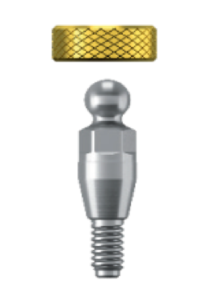
- 1 torque wrench for prosthesis 10 – 40 N.cm
- 3 external hex keys (short/medium/long)
- 2 external hex mandrels (short/long)
- 3 internal hex keys:
- For Tetra straight abutment
- For Obi implant and O-Ring abutment (short/long)
- 2 internal hex mandrels:
- For Tetra straight abutment
- For Obi implant and O-Ring abutment (short/long)
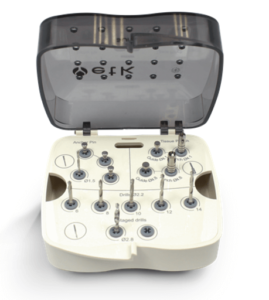
Abutments adapted to all of your clinical situations
Wide selection of supra-implant heights 2 angles of 17° and 30° to compensate for divergences between implant and prosthetic axes.
Clinical indications
Partial and full bridges Screw-retained crown only on Tetra straight abutment For entire mouth sector
Stable and passive bridge
4.8 mm wide platform for passive and stable positioning of the prosthesis Adapted to early or immediate loading of multi-unit cases.
Ergonomic design to simplify your handling
The abutments are supplied with abutment holders to make it easier to pick up and position them in the relation to the desired prosthetic axis.
For single-unit cases, preservation of the biological width for a better aesthetic result
Immediate and permanent placement of the abutment to preserve the connective tissue Direct impression taking on the abutment.
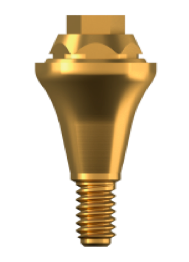
Abutments adapted to all of your clinical situations
Wide selection of supra-implant heights 2 angles of 17° and 30° to compensate for divergences between implant and prosthetic axes Reduced platform of 3.8 mm for restricted dimensions
Clinical indications
Partial and full bridges For entire mouth sector
Ergonomic design to simplify your handling
The abutments are supplied with abutment holders to make it easier to pick up and position them in the relation to the desired prosthetic axis.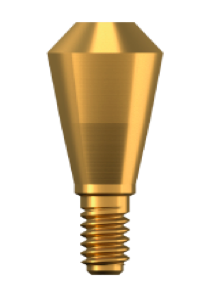
Clinical indications
Single-unit and multi-unit edentulism For entire mouth sector
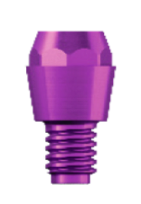
Tailor-made and aesthetic prosthesis
For performing your complex cases Production by our expert centre Teknika Lab: of personalised titanium abutments in CAD/CAM of zirconia abutments on esthetibase titanium bases.
Clinical indications
Single-unit, multi-unit and complete edentulism For entire mouth sector
Compatibility with the main competitor systems
Personalised abutments, scanbodys for digital impressions and Esthetibase interfaces are also available for the main competitor implant brands


